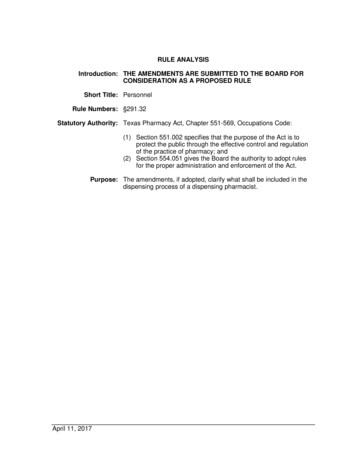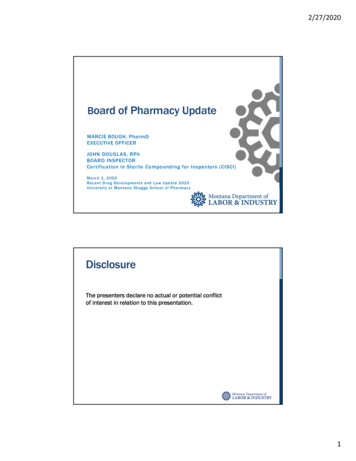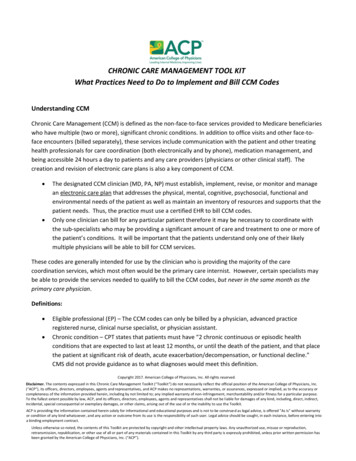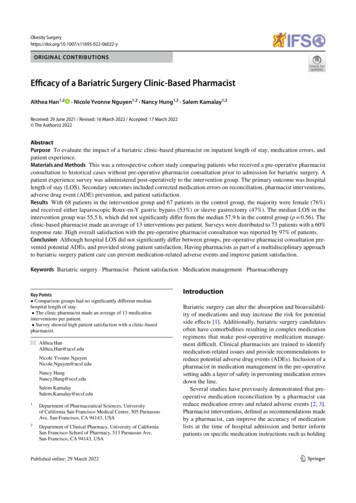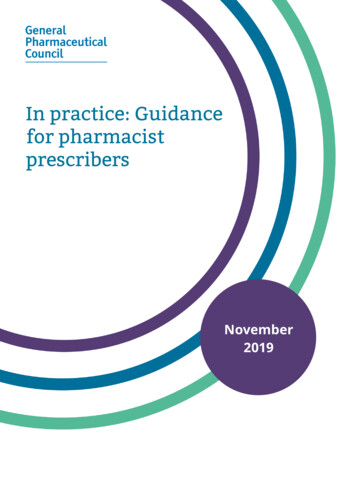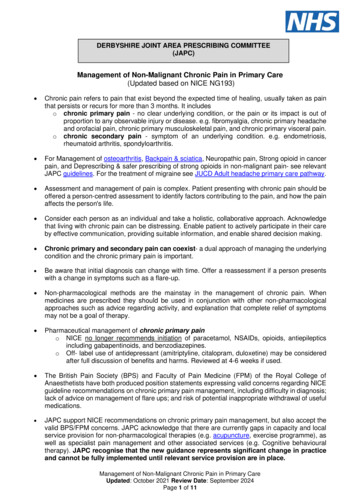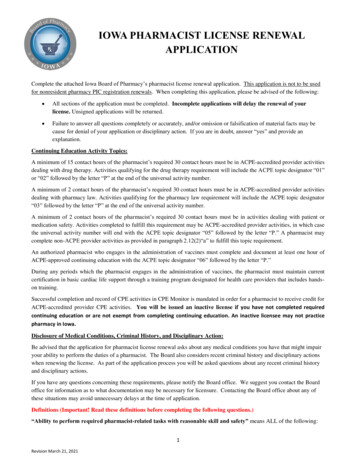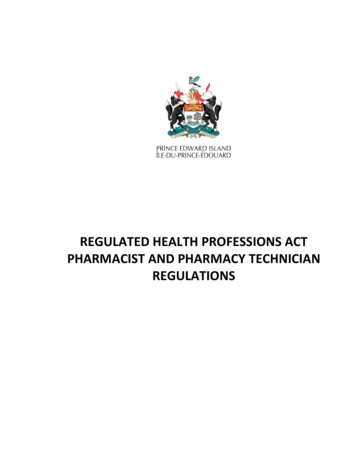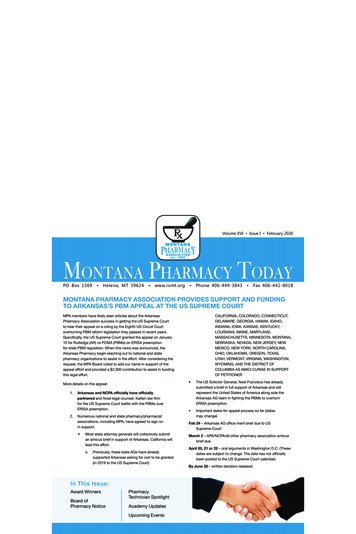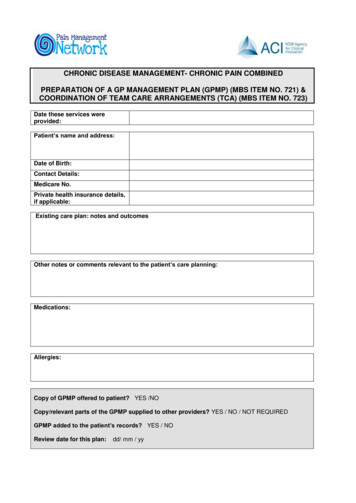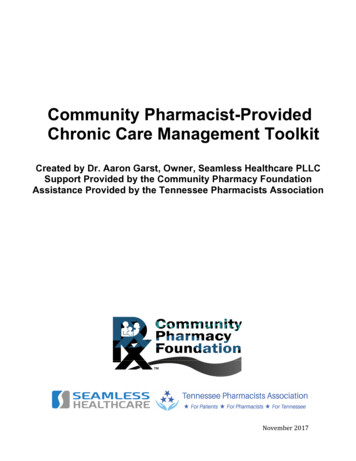
Transcription
Community Pharmacist-ProvidedChronic Care Management ToolkitCreated by Dr. Aaron Garst, Owner, Seamless Healthcare PLLCSupport Provided by the Community Pharmacy FoundationAssistance Provided by the Tennessee Pharmacists AssociationNovember 2017
Table of ContentsOverview .1The Community Pharmacist-Provided CCM Guide .1Patient Eligibility 1Certified Electronic Health Records (CEHR) .2Initiating Visits .3Patient Consent .3Comprehensive Care Plan Creation .4Provision of CCM Services . .5Access to Care & Continuity . 5Comprehensive Care Management . 6Transitional Care Management . 6Incident-To Billing Overview . .7Final Thoughts . 8Additional Resources 9Appendix A: Example BAA 10Appendix B: Example CPPA (Specific to TN) . 16Appendix C: Example CCM Comprehensive Care Plan . 20Appendix D: Medicare Preventive Service Checklist .26November 2017
OverviewIn 2015, the Centers for Medicare and Medicaid Services (CMS) began paying providersseparately for Chronic Care Management (CCM) services. CCM is a time based, predominantlynon-face-to-face, service provided to patients in between office visits. CCM is very similar to a permember per month (PBPM) payment strategy since it may be billed monthly if enough clinical stafftime is spent providing care to enrolled patients. Clinical staff may include a pharmacist, and sinceCCM billing allows for general supervision under “incident to” billing rules, community pharmacistshave an opportunity to provide these services outside of a physician’s office.CCM has faced implementation challenges possibly due to the requirement to collect a copayand/or the low provider reimbursement rate relative to the time required to deliver the service. In2015, Medicare claims data indicated that approximately 275,000 eligible Medicare beneficiariesreceived CCM services an average of 3 times during that year. However, with roughly 40 millionMedicare beneficiaries who may be eligible for a monthly CCM, many of these Medicare patientsfailed to receive CCM and providers failed to deliver and bill for over 18 billion in revenue.With support from the Community Pharmacy Foundation (CPF) and assistance by theTennessee Pharmacists Association (TPA), Seamless Healthcare PLLC explored the delivery ofcommunity pharmacist-provided CCM services with an endocrinologist. The Community PharmacistProvided Chronic Care Management Toolkit contains guidance, resources, and experiences to aid inthe establishment and provision of CCM services by a community pharmacist. Additional materialsfound at the end of this toolkit include a sample Business Associate Agreement (BAA), CollaborativePharmacy Practice Agreement (CPPA), and a comprehensive care plan. Hopefully this toolkit willcreate more provider collaboration, better patient health outcomes, and additional revenue tocommunity pharmacists.The Community Pharmacist-Provided CCM GuideThis guide provides all the steps necessary to perform community pharmacist-provided CCMservices in conjunction with a physician. Each section will detail general information andrequirements for the provision of CCM services followed by CPF pilot experiences. Sections includeinformation regarding:1.2.3.4.5.6.Patient EligibilityCertified Electronic Health Records (CEHR)Initiating VisitsPatient ConsentComprehensive Care Plan CreationProvision of CCM Servicesa. Access to Care & Continuityb. Comprehensive Care Managementc. Transitional Care Management7. Incident-To Billing OverviewIn general, providing and billing for CCM services includes six major steps that begin in thephysician’s office and could end in the community pharmacy:Physician’s OfficeDetermine Eligibility à Assist in Initiating Visit à Obtain Consent à Create Care PlanCommunity PharmacyProvide Monthly CCM Services with Physician’s CEHR à Bill Incident to the PhysicianPatient EligibilityGeneral Information/RequirementsThe two main components that determine patient eligibility for CCM include insurance carrier andnumber of chronic conditions.Patients with traditional Medicare coverage, including those who are Dual Eligible, are1November 2017
guaranteed to be eligible for CCM services. If the patient has Medicare, but there is concern abouteligibility, check with the state Medicare Administrative Contractor (see “Additional Resources”).While Medicare Advantage plans may allow for billing of CCM services, the provider will need toconfirm directly with each carrier prior to delivering CCM services.CMS states that patients must have multiple (two or more) chronic conditions expected to last atleast 12 months, or until death, and that place the patient at significant risk of death, acuteexacerbation/decompensation, or functional decline. CMS does not limit which chronic conditionsmake a patient eligible for CCM, which gives providers flexibility to enroll patients who will benefitthe most.A few examples of chronic conditions include, but are not limited to, the following: Alzheimer’s Disease/Related DementiaArthritis (OA and RA)AsthmaAtrial FibrillationAutism Spectrum DisordersCancer Cardiovascular PF Pilot ExperienceTo be applicable nationwide, this pilot focused on patients with traditional Medicare coveragesince Medicare Advantage allowable services can vary based on locality and carrier. Using thephysician’s CEHR, all scheduled patients with traditional Medicare coverage were flagged. Flaggedpatients were then selected for CCM if they had two or more disease states (e.g. type 2 diabetes,hypo/hyperthyroidism, obesity, hypertension, dyslipidemia) that the community pharmacist couldmanage under a CPPA.Certified Electronic Health Record (CEHR)General Information/RequirementsStarting in 2017, CMS relaxed the CEHR requirements related to CCM and only requires aCEHR be used to document core clinical information (i.e. demographics, problems, medications,medication allergies). Most physicians are already utilizing an acceptable CEHR because of theirinvolvement in the EHR Incentive Programs (see “Additional Resources”). If a partnering physicianhas not been involved in the EHR Incentive Program, make sure to contact the physician’s CEHRvendor to ensure that all requirements will be met for provision of CCM services.Certified technology is no longer required for other CCM documentation (i.e. CCM encounters,other providers labs), transitional care management documents, or when sharing care planinformation within and outside the practice. These changes have allowed for the exchange of CCMinformation to be via fax. Additionally, individuals providing CCM after hours are no longer requiredto have access to the electronic care plan as long as they can access information in a timelymanner. Reducing these requirements has decreased the administrative burden in a number ofoffices that provide CCM, since not all have interoperable CEHRs like larger health systems.CPF Pilot ExperienceImplementation of CCM services was very easy since the partnering physician was already setup with a CEHR. The 2017 changes were very beneficial when moving information betweenproviders. While having an interoperable CEHR between all providers would be beneficial, this wasnot the current reality as faxing was still one of the easiest ways to exchange documentation.The community pharmacist had 24/7 remote access to the CEHR even though it was no longera requirement. All providers, including the community pharmacist, thought remote access wascrucial to the delivery of high quality CCM since documentation was such an important element.Remote, 24/7 access to pertinent information proved to be important during CCM calls. This wasespecially true when modifying therapies and sending in new/refill prescriptions on the weekends.2November 2017
Even though it is not a requirement, community pharmacists should insist on having remote accessto the CEHR when establishing CCM services.Initiating VisitGeneral Information/RequirementsInitiating CCM depends on whether a patient is either: New to the practiceAn existing patient who has not been seen for a comprehensive visit within one yearAn existing patient who has been seen for a comprehensive visit within one yearFor new patients or existing patients not seen for a comprehensive visit within one year prior toCCM enrollment, CMS requires CCM initiation during a face-to-face comprehensive visit with thebilling practitioner. Comprehensive visits include an Annual Wellness Visit (AWV), Initial PreventivePhysical Examination (IPPE), Transitions of Care Management (TCM), or a level 3, 4, or 5Evaluation and Management (E/M) visit. Pharmacists can provide AWVs in full, or play a role in anyof the other initiating visits, which can create an opportunity for split billing. The initiating visits buildrelationships and credibility with prescribers, and increase CCM enrollment through face-to-facepatient-pharmacist relationships. More information about AWV, IPPE, TCM and E/M can be found inthe “Incident-To Billing Overview” and “Additional Resources” sections below.For existing patients seen for a comprehensive visit within one year, CCM may be initiated overthe phone without an additional in-office visit. While this is allowed, a comprehensive care planmust still be created, which could be difficult if the patient has had drastic changes in their healthstatus since their last visit.CPF Pilot ExperienceImmediately prior to being seen by the physician or nurse practitioner for an E/M visit, thecommunity pharmacist provided medication reconciliation services to eligible patients. Medicationreconciliation created an opportunity for the pharmacist to determine medication related issues andgenerate recommendations to be discussed with the patient and their corresponding provider. Faceto-face interaction with patients and providers created relationships, credibility, and trust thatincreased patient enrollment in CCM and pharmacist autonomy under the CPPA.The community pharmacist reached out to some patients seen in the past year to discuss CCMenrollment. It was found that enrollment in CCM was non-existent when “cold calling” patientscompared to meeting the community pharmacist in person during a face-to-face visit. Potentialreasons why patients refused CCM over the phone included not knowing the pharmacist personally,feeling as though they are being sold something, or not recognizing the pharmacist’s relationshipwith the providers in the office.Patient ConsentGeneral Information/RequirementsTo ensure patient engagement, obtaining consent during CCM enrollment is required by CMSprior to performing any CCM services. Patient consent must at least inform patients of: 3The availability of CCM serviceso 24-hour-a-day, 7-day-a-week access (explained in-depth under “CCM Services”)The applicable cost sharing (patient pays 20% when only covered with Medicare)o Private insurers providing standardized Medigap plans agree to cover the copay,unless the Medigap policy itself has a deductible that has not yet been met (e.g.,high deductible Plan F)o Dual eligible patients who are considered “Qualified Medicare Beneficiaries,” orQMBs, are not responsible for cost sharing. Depending on the Medicaid stateplan, the physician’s office may or may not have to absorb the copay for QMBs.All other Dual Eligible statuses (Non-QMB, SLMBs, QDWIs, QI-1, or QI-2) withNovember 2017
need to pay the applicable copay.That only one practitioner can furnish and be paid for CCM services during a calendarmonthThe right to stop CCM services at any time (effective at the end of the calendar month)Consent may be verbal or written, but must be documented in the CEHR.CPF Pilot ExperienceImmediately after the initiating visit with the provider, interested patients would meet again withthe community pharmacist briefly to obtain verbal consent, additional information as needed for thecomprehensive care plan, and a printed copy of their preliminary comprehensive care plan. As canbe seen in the “Example CCM Comprehensive Care Plan” at the end of this toolkit, a disclaimer canbe placed at the top of the care plan stating when the patient consented and what services will beprovided. While verbal consent is allowed, some practices may want to consider having patientssign a consent form to ensure there is no patient misunderstanding.Comprehensive Care Plan CreationGeneral Information/RequirementsThe comprehensive care plan is not only a necessity for billing, but it helps guide the communitypharmacist when treating patients enrolled in CCM. CMS emphasizes comprehensive care plansshould be patient-centered and encompass all health issues, with a particular focus on the chronicconditions being managed. The care plan must be electronic, provided to the patient and/orcaregiver to encourage patient engagement, and also to any other individuals involved in thepatient’s care.Comprehensive care plans are practice site specific and typically include, but are not limited to,the following elements: Problem listExpected outcome and prognosisMeasurable treatment goalsSymptom managementPlanned interventions and identification of individuals responsible for each interventionMedication ManagementCommunity/social services orderedA description of how services outside the practice will be directed/coordinatedSchedule for periodic review and, when applicable, revision of the care planAs stated above, comprehensive care plans will be dependent on the practice site (i.e. primarycare, endocrinology, cardiology) but should encompass all issues even if scope is limited within thepractice site. To account for this, CMS created an add-on code for patients who receive an initiatingvisit and the billing physician or qualified healthcare professional (i.e. nurse practitioner, physicianassistant) personally performs extensive assessment and CCM care planning beyond the usualeffort. This code is called “Comprehensive Assessment of and Care Planning for CCM” and itscorresponding HCPCS code is G0506.CPF Pilot ExperienceBuilding a comprehensive care plan can be difficult if the patient is seeing multiple providers.During the pilot, patients received a printed care plan immediately after enrollment generated frominformation available in the office’s CEHR. A list of providers was obtained prior to patients leavingand the community pharmacist contacted them for recent lab values, procedures, and/or patientnotes. This information was included in the final care plan, disseminated back to the other providers,and an updated copy was mailed to the patient/caregiver. The example comprehensive care planfound at the end of this toolkit should be utilized as a guide to building a specific care plan templatetailored to the physician’s office. Offices utilize different CEHRs and have different ways of4November 2017
documenting, so what is found in the example will expedite, but probably not replace, creating aunique comprehensive care plan template. The CEHR vendor that the physician utilizes should becontacted about the possibility of creating, or implementing existing, CCM templates. Utilization ofCCM platform vendors outside of the physician’s CEHR is not encouraged because of the possibilityof fees and duplication of work (e.g. documenting in outside vendor and then scanning intophysician’s CEHR).The G0506 code was not used during the pilot since the community pharmacist built thecomprehensive care plans and the focus was on the 20 minute CCM billing code. While G0506 canbe used with patients considered normal complexity, it has more value when patients are consideredmoderate/high complexity and require 60 or more minutes of clinical staff time during CCM.Misusing or abusing this code (i.e. using with every comprehensive care plan created) should not beconsidered and would most likely lead to CMS scrutiny and audits for overbilling.Provision of CCM ServicesGeneral Information/RequirementsProviding CCM services encompasses three major elements that include:1. Access to Care & Continuity2. Comprehensive Care Management3. Transitional Care ManagementIn general, these three elements create an access point for patients and/or caregivers to reachout to a healthcare provider (i.e. the community pharmacist) in a timely manner to prevent worseningconditions or hospitalizations.Access to Care & ContinuityCMS states that access to care and continuity shall include: 24-hour-a-day, 7-day-a-week (24/7) access to physicians, other qualified health careprofessionals or clinical staff, while providing patients (and caregivers as appropriate)with a means to make contact with health care professionals in the practice to addressurgent chronic care needs regardless of the time of day or day of the week.o While 24/7 access may seem overwhelming, achieving this requirement is typicallynot difficult as most physicians offices already have a system for after-hour calls.CMS also allows for “timely” return of phone calls, so phone calls can be missedas long as the patient is contacted as soon as possible. In case of missed calls, avoicemail should be set up that states “if this is an emergency, please hang up andcall 911.” Most patients are very conscientious of calling during business hours,but even so, they must have the ability to reach a provider anytime. Continuity of care with a designated member of the care team with whom the patient isable to schedule successive routine appointmentso Typically the designated member is the practitioner who provided the initiatingvisit, but it could include other practitioners involved in the patients care. Enhanced opportunities for the patient and any caregiver to communicate with thepractitioner regarding the patient’s care by telephone and also through securemessaging, secure Internet, or other asynchronous non-face-to-face consultationmethods (for example, email or secure electronic patient portal)o Most physicians will have a CEHR program set up that allows for patients tosecurely reach a “patient portal” to email providers. Patients should have directtelephone access to the community pharmacist (i.e. business cell phone) involvedin their care. Pharmacy managers might also consider training other communitypharmacy personnel on CCM workflow for when the patient calls the pharmacydirectly.5November 2017
Comprehensive Care ManagementCMS states that comprehensive care management shall include: Systematic assessment of the patient’s medical, functional, and psychosocial needso While community pharmacists are not diagnosticians, they do have the abilitytriage care when notice medical, functional, and/or psychosocial changes.Community pharmacies that provide point-of-care testing and other clinicalservices will be able to assess potential problems in a more efficient manner. System-based approaches to ensure timely receipt of all recommended preventive careserviceso After determining patient-specific preventive care services, creating a system offeedback loops is important. All providers should be listed in the care plan andmatched with their corresponding scope of services. During CCM calls, patientsshould be reminded of recommended services and assisted with coordinating thiscare. Medication reconciliation with review of adherence and potential interactionso During the initial visit, community pharmacists could consider selecting MTMeligible patients. This would allow for a pharmacy to bill for the CMR through PartD, while also providing other clinical services in the physician’s office through PartB. Oversight of patient self-management of medicationso Community pharmacists are in an optimal position to ensure patients arecompliant to therapy through CCM. Enrolling patients in medicationsynchronization and delivery could aid in a patient’s self-management of theirmedications. Coordinating care with home and community based clinical service providerso Most community pharmacists know of available home and community basedservice providers in their area. If this is not the case, utilizing your state pharmacyassociation or local aging and disability resource can provide a starting point tolearning about the potential options available.Transitional Care ManagementCMS states that transitional care management shall include: Manage transitions between and among health care providers and settings, includingreferrals to other clinicians, follow-up after an emergency department visit, or facilitydischargeo Managing transitions through CCM is not the same as providing the TCMMedicare Part B billable service (see under “Incident-To Billing Overview”), but itis an opportunity to possibly set TCM services up with the partnering PCP orhealth system. While this toolkit does not get into the specifics of TCM billing,elements do include patient contact within 48 hours of discharge and medicationreconciliation prior to the face-to-face visit with the provider. Timely creation and exchange of continuity of care document(s) with other practitionersand providerso See section “CEHR Requirements” for more information.CPF Pilot ExperienceMany patients were hesitant of community pharmacist-provided CCM during enrollment, butthose that did enroll really enjoyed the access to a community pharmacist who had a totalunderstanding of their current health status. The provider who conducted the initiating visit wascrucial to reinforcing the benefits of CCM services and boosting enrollment. Patients trust theirproviders, and this trust translates into credibility for the community pharmacist-provided CCM6November 2017
services. After enrollment, the community pharmacist could easily modify therapies, order refills,and/or coordinate care with their other providers while practicing under the CPPA.Providing 24/7 access was not too burdensome during the pilot since an existing system wasalready in place through the physician’s office. No patients called during the middle of the night andmost calls were during the week in typical business hours. While patients had the ability to contactthe community pharmacist or providers through email or a patient portal, most patients preferrednon-face-to-face consultation via phone with the community pharmacist. When patients called,having remote access to the physician’s CEHR was crucial to access the care plan, modifytherapies, issue prescriptions or refills, and document the encounter. Using the same CEHR as thephysician ensures no limitations when providing patient care.The average time spent providing CCM clinical services was roughly 25 minutes per patient eachmonth. Even though some patients required over 40 minutes of time, 99490 could not be billedmultiple times (i.e. billing two 99490 codes for 40 minutes of time). This presents an issue whenpatients are not moderate or high complexity but utilize the service more than 20 minutes per month.Community pharmacists and the partnering practice need to consider developing a system forreferring a normal complexity patient to an office visit (i.e. if the patient reaches the 40 minute mark,they will need to schedule a visit). If the patient can be deemed moderate or high complexity,utilization of billing codes 99487 and 99489 should be considered. These codes are discussedbelow in “Incident-To Billing Overview.”To ensure timely receipt of all preventive care services, all providers were sent a “MedicarePreventive Service Checklist” created during the grant (see also “Additional Resources”). Thechecklist allowed the providers an opportunity to select which services the patient needed to receive.The checklist was a great guide for patients to know which services they needed to have completed,and should be attached with the care plan. The “Medicare Preventive Service Checklist” can befound in Appendix D.No patients enrolled in CCM were hospitalized during the grant, which hopefully was attributedby the delivery of CCM services.Incident-To Billing OverviewGeneral Information/Requirements“Incident to” services are defined as those services that are furnished by a non-physicianpractitioner, or other clinical staff (pharmacists included), incident to a physician’s professionalservices. These services are billed as though the physician personally provided them and are paidthe full rate under the physician fee schedule (PFS). “Incident to” services are also relevant toservices supervised by certain non-physician practitioners (i.e. physician assistants, nursepractitioners, clinical nurse specialists). These services are subject to the same requirements asphysician-supervised services, but reimbursement is 85 percent of the PFS. Since non-physicianpractitioners typically practice under a physician in some capacity, it is always best to try and billincident to the physician so the practice can receive the full PFS.To qualify as “incident to,” services must be part of the patient’s normal course of treatment,during which a physician personally performed an initial service and remains actively involved in thecourse of treatment. Supervision requirements are based on the service provided and will requireeither direct or general supervision. Direct supervision means the service is provided in the officesuite where the billing physician is present. The physician must be present to render assistance, asnecessary, but it does not have to be physically present in the patient’s treatment room while theseservices are provided. General supervision means the service is furnished under the physician'soverall direction and control, but the physician's presence is not required during the service. Thus,general supervision allows for services to be conducted outside the physician’s office, but thepractitioner providing the service must be able to reach the supervising physician in a timelymanner.Table 1 presents current Part B services where pharmacists could play a role. Pharmacists canprovide all components of the AWV or CCM without physician involvement (i.e. “incident to”). All7November 2017
other services listed must be provided in a “split billing” fashion, where a pharmacist provideselements of a service that still requires physician involvement. While this toolkit focuses on CCM inpatients with normal complexity, the “Additional Resources” section of this document provides linksto other Part B service guides. This toolkit, plus the additional resources, can be utilized together tocreate a hybrid model of community pharmacist-provided care in an ambulatory care setting.Table 1: Part Billing Codes for Pharmacist-Provided ServicesBilling Code DescriptionSupervision Billing Code Payment*Chronic Care Management - Normal (20 min)General99490 43Chronic Care Management - Moderate/High (60 min)General99487 94Chronic Care Management - Moderate/High (30 min)General99489** 47Comprehensive Assessment/Care Planning for CCMN/AG0506 64Annual Wellness Visit (Initial)DirectG0438 166Annual Wellness Visit (Subsequent)DirectG0439 111Initial Preventive Physical ExaminationDirectG0402 159Transitional Care Management - ModerateDirect99495 164Transitional Care Management - HighDirect99496 231Evaluation and ManagementDirect99211*** 20Direct99212 37Direct99213 59Direct99214 88Direct99215 119*Payment is based on current rates in Tennessee as of this writing. Payments vary based ongeographic region and if the service is performed in a hospital or physician’s office. The CMS PFStool (see “Additional Resources”) can be utilized to determine payment in your area.**Code is only reported in conjunction with 99487***Code can bill billed by a pharmacist directly (i.e. without “incident to” billing methods)CPF Pilot ExperienceThe endocrinologist’s patient insurance mix included Medicare only, Medicare plus supplement,and Dual Eligibles. All patients billed for CCM service 99490 (20 minutes) were successfullyreimbursed by Medicare. All supplement plans paid the applicable copay and patients paid nothingout of pocket if they had met their deductible. For those without a supplement, the copay wascollected at the next office visit. If the scheduled office visit was over three months away, patientswere sent a bill through the mail. The copay was absorbed by the practice for Dual eligible patientswho were considered QMBs.While the grant focused on 99490, this guide is applicable to providing and billing for 99487 and99489. The main difference is the physician or non-physician practitioner will need to deem thepatient as moderate/high complexity in the care plan. Once deemed moderate/high complexitybased on E/M rules (see “Additional Resources”), the community pharmacist can bill for up to 60minutes time (99487) with an additional 30 minute modifier (99489). It should be noted that 99489can not be billed in conjunction with 99490. Community pharmacists should work closely with thepartnering physician or non-physician practitioner each month to determine a patients’ changinghealth status and necessary time spent providing care through CCM.Final ThoughtsThis grant confirmed that community pharmacists are able to provide and bill for CCM outside ofa physician’s office. CCM should be considered as one of many services a community pharmacistcan provide to physicians and their patient panel. Community pharmacists should utilize this toolkitto as a resource to expedite the formation of CCM services and should consider utilizing othertoolkits found on the CPF website to supplement and diversify revenue streams.8November 2017
Additional ResourcesResourceAWV GuideCCM OverviewCCM WebpageCCM 2017 ChangesCCM Billing FAQCEHR RequirementsCMS MAC WebsiteE/M GuideIPPE GuideMedicare Preventive Service WebsitePFS Look-Up To
cms states that transitional care management shall include: manage transitions between and among health care providers and settings, including referrals to other clinicians, follow-up after an emergency department visit, or facility discharge o managing transitions through ccm is not the same as providing the tcm medicare part b billable

